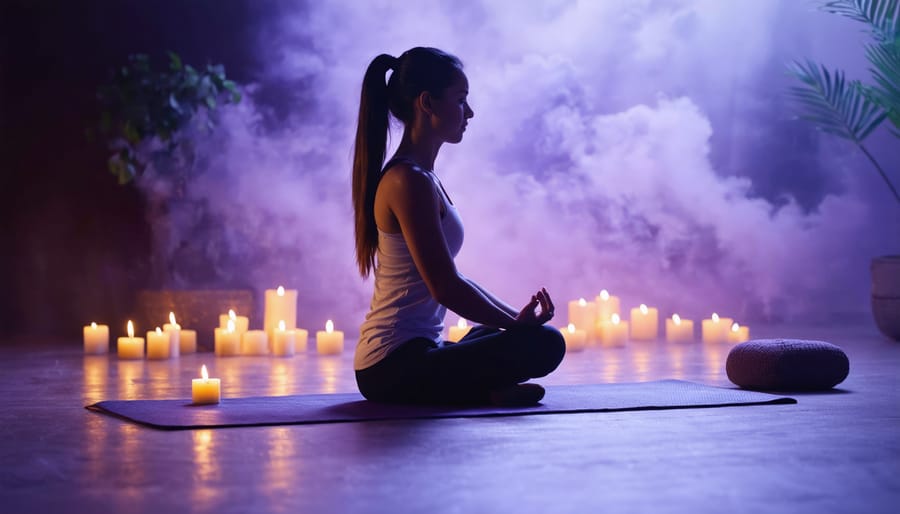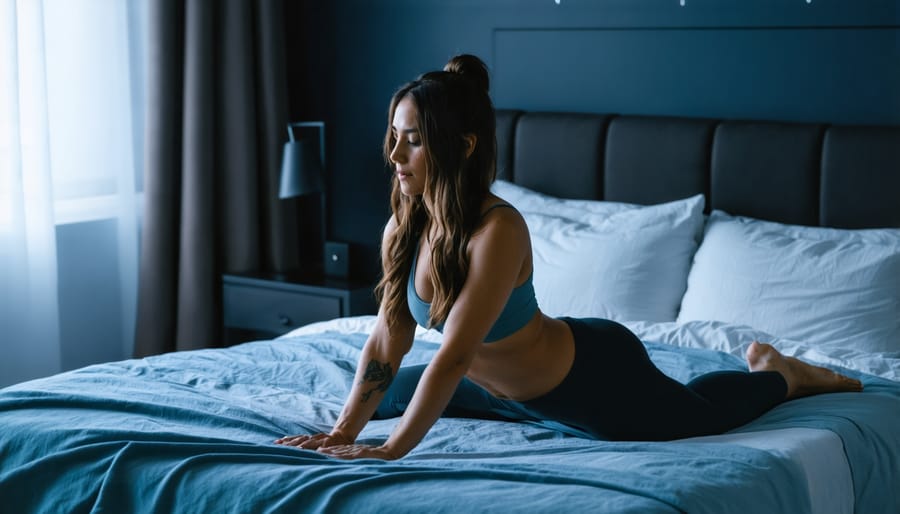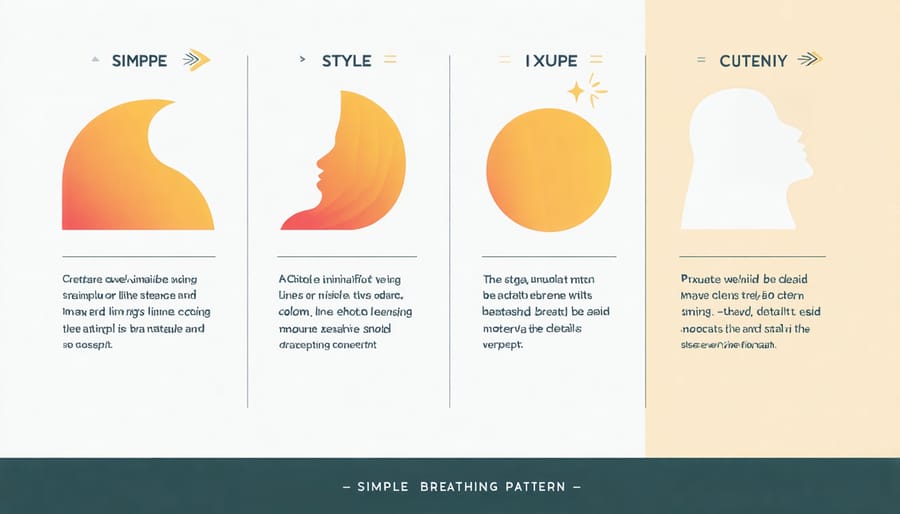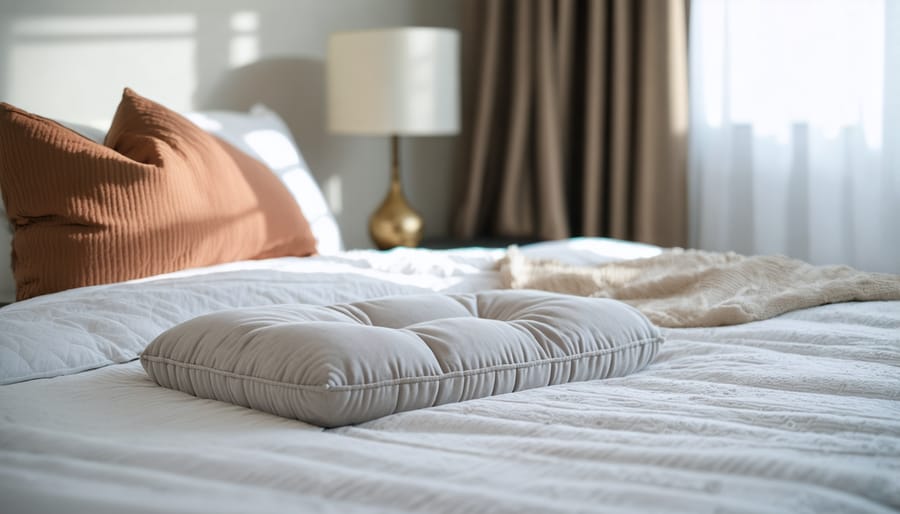
Gentle stretches and mindful breathing merge seamlessly in guided sleep meditation movement, creating a powerful pathway to mindful, restorative rest. As someone who struggled with racing thoughts at bedtime, I discovered that combining soft, flowing movements with meditation transforms the nightly wind-down routine into a sacred ritual of self-care.
Picture yourself flowing through gentle yoga-inspired stretches while following a soothing guided meditation – it’s like giving your body and mind permission to release the day’s tension simultaneously. This mindful movement practice acts as a natural bridge between daytime energy and nighttime calm, helping you transition into sleep with greater ease and deeper relaxation.
The beauty of this practice lies in its accessibility – you don’t need special equipment or years of meditation experience. Whether you’re a busy professional seeking better sleep quality or simply looking to enhance your evening routine, guided sleep meditation movement offers a gentle yet effective path to more restful nights. By engaging both body and mind, this practice creates the perfect conditions for your nervous system to shift into rest mode naturally.
Why Mindful Movement Matters for Sleep
The Mind-Body Connection
Have you ever noticed how a gentle evening stretch can instantly calm your racing thoughts? This beautiful connection between movement and mental state is no coincidence. Our bodies and minds are intricately linked, and understanding this relationship is key to achieving better sleep through mindful body awareness.
When we engage in gentle, mindful movement before bed, we’re not just preparing our bodies for rest – we’re also signaling to our brains that it’s time to wind down. Think of it as a conversation between your physical and mental self. As you move with intention, your muscles release tension, your breathing naturally deepens, and your nervous system begins to shift from its active “fight or flight” mode to a calmer “rest and digest” state.
I’ve found that even simple movements, like gentle neck rolls or seated twists, can create a profound shift in how ready we feel for sleep. It’s like pressing a reset button that helps align your physical experience with your desire for rest. The key is to move slowly and intentionally, paying attention to how each movement affects your state of mind.
Benefits of Pre-Sleep Movement
Like many of my clients, I used to hop straight from my desk to my bed, wondering why sleep felt so elusive. That’s when I discovered the magic of gentle pre-sleep movement. Moving your body mindfully before bed helps release physical tension that accumulates throughout the day, particularly in your shoulders, neck, and lower back.
This gentle activity triggers the release of endorphins, nature’s stress-relievers, while avoiding the intense energy boost that comes with vigorous exercise. When you combine soft stretches with mindful breathing, you’re essentially creating a bridge between your busy day and restful night.
Pre-sleep movement also helps regulate your body temperature. The slight rise in temperature during movement, followed by the natural cool-down, mirrors your body’s natural sleep cycle, making it easier to drift off. Plus, these gentle movements can help quiet a racing mind by shifting your focus to physical sensations rather than pending tasks or worries.
Think of it as pressing a gentle reset button, allowing both your body and mind to transition into sleep mode naturally and peacefully.
Creating Your Bedtime Movement Practice

Gentle Stretches for Better Sleep
As someone who’s struggled with restless nights, I’ve discovered that gentle stretching before bed can be a game-changer. When combined with the benefits of mindful movement, these simple stretches can help your body and mind transition into sleep mode naturally.
Start by sitting on the edge of your bed and gently rolling your shoulders backward and forward. Next, try a seated forward bend – extend your legs in front of you and reach for your toes, focusing on the sensation of lengthening rather than touching them. Hold each position for 3-5 deep breaths.
While lying down, hug your knees to your chest, one at a time, then both together. This gentle compression helps release lower back tension that builds up during the day. Follow with a supine twist: lie on your back, bring your knees to one side while keeping both shoulders grounded, then switch sides.
End with my personal favorite – legs up the wall. Simply scoot your bottom close to the wall and extend your legs up, forming an L-shape. This gentle inversion can help reduce swelling in your legs and calm your nervous system. Stay here for 5-10 minutes, focusing on your breath and letting go of the day’s tensions.
Remember, these stretches aren’t about perfection or pushing yourself. Move slowly, breathe deeply, and listen to your body’s signals. The goal is relaxation, not flexibility.
Mindful Breathing Techniques
Let’s explore some gentle breathing techniques that naturally complement your mindful movement practice. I discovered these techniques during my own sleep journey, and they’ve become my go-to methods for winding down at night.
Start by finding a comfortable seated position or lying down. As you settle in, notice your natural breath without trying to change it. Now, try synchronizing your breath with gentle movements: raise your arms slowly as you inhale, and lower them as you exhale. This simple coordination helps your body and mind work together, creating a peaceful rhythm.
One of my favorite techniques is the “4-7-8” breath combined with gentle stretching. Inhale for four counts while extending your spine, hold the breath for seven counts as you maintain the stretch, then exhale for eight counts while slowly releasing. This pattern naturally calms your nervous system and prepares your body for rest.
Another soothing practice is “ocean breath” or ujjayi breathing. Create a soft sound like ocean waves in the back of your throat while breathing through your nose. Try this while gently rolling your shoulders or moving your head from side to side. The combination of sound, breath, and movement creates a meditative state that’s perfect for transitioning into sleep.
Remember, these techniques should feel comfortable and natural. If any movement or breathing pattern feels strained, modify it to suit your needs.

Progressive Relaxation Flow
Let’s explore a gentle progressive relaxation sequence that combines mindful movement with deep relaxation – perfect for preparing your body and mind for sleep. Start by lying comfortably on your back, taking a few deep breaths to center yourself.
Begin with your toes, gently curling and uncurling them while focusing on the sensation. Slowly rotate your ankles in circular motions, three times in each direction. Move up to your calves and thighs, alternating between gentle tension and complete relaxation.
As you reach your hips, make small, circular movements, releasing any tension stored in your lower back. Let your arms rest naturally by your sides, gradually working through each finger, rotating your wrists, and moving up through your arms. Roll your shoulders forward and back, creating space in your upper body.
Finally, release any tension in your neck with gentle head rolls, being mindful not to strain. Throughout this sequence, maintain steady, deep breathing, and pause whenever you feel the need to settle more deeply into a particular movement.
Remember, this isn’t about perfect execution – it’s about creating a mindful connection between your breath, body, and the present moment. If you notice your mind wandering, gently guide it back to the sensations in your body. This flowing sequence typically takes about 10-15 minutes, though you’re welcome to extend it if you’re finding particular benefit in certain movements.
Making It Part of Your Nightly Routine
Setting the Scene
Creating your perfect sleep sanctuary begins with intentional preparation. Just as you wouldn’t attempt a challenging yoga pose without warming up, your journey to restful sleep through mindful movement needs the right environment to flourish. Let’s transform your space into a haven that nurtures the mind-body connection.
Start by dimming the lights about an hour before your practice. This natural signal helps your body recognize it’s time to wind down. Choose a quiet corner of your home where you won’t be disturbed – it doesn’t need to be large, just enough space to stretch your arms and legs comfortably.
Temperature plays a crucial role in your practice. Keep your room slightly cool, around 65-68°F (18-20°C), as this helps promote better sleep. Consider using soft, breathable materials for your practice space, like a plush yoga mat or comfortable blanket.
Remove potential distractions by turning off phone notifications and clearing any clutter from your immediate surroundings. You might want to add gentle touches that engage your senses – perhaps a light lavender scent, soft instrumental music, or the warm glow of flameless candles.
Remember, this is your personal sanctuary. Make it feel special and inviting, somewhere you look forward to spending time each evening as you prepare for rest.

Timing Your Practice
Like many of my clients, I used to struggle with finding the “perfect” time for my mindful movement practice. Here’s what I’ve learned: the best time is when it works consistently for you. However, for optimal results with guided sleep meditation and mindful movement, aim to practice 30-45 minutes before your intended bedtime.
This timing allows your body to move gently while gradually winding down, without being so close to bedtime that you’re too tired to focus. I’ve found that practicing any earlier than two hours before bed might not have the same sleep-inducing benefits, while leaving it until you’re already in bed might make you too sleepy to complete the practice mindfully.
Start with 10-15 minutes if you’re new to the practice. You might be surprised how even this short duration can make a difference in your sleep quality. As you become more comfortable, gradually extend your sessions to 20-30 minutes. Listen to your body – some nights you might need a longer practice, while others might call for just a few mindful stretches and breaths.
Consistency matters more than duration. It’s better to practice for 10 minutes every night than to do an hour-long session once a week. Create a routine that feels sustainable and enjoyable rather than another item on your to-do list.
Common Challenges and Solutions
When You’re Too Tired
We’ve all been there – those evenings when even the thought of movement feels overwhelming. On days when your energy reserves are running low, it’s perfectly okay to modify your practice. Instead of a full sequence, try gentle stretches while lying in bed. Focus on small, mindful movements like shoulder rolls, ankle rotations, or simply wiggling your toes with awareness.
Remember that mindful movement doesn’t always mean physically moving your body. You can practice mental movement meditation by visualizing peaceful walking or floating sensations while remaining still. This approach can be equally effective for preparing your mind and body for sleep.
If you’re experiencing particularly low energy, simply focus on your breath. Place one hand on your belly and feel the natural rise and fall as you breathe. This minimal movement practice combined with breath awareness can help transition your body into sleep mode without requiring additional energy.
The key is being gentle with yourself and recognizing that some mindful movement is better than none at all. Even the smallest intentional movements, when paired with conscious breathing, can help guide you toward restful sleep.
Maintaining Consistency
Building a consistent practice of guided sleep meditation and mindful movement doesn’t have to feel like another item on your to-do list. As someone who struggled to maintain this habit initially, I’ve found that starting small and being gentle with yourself is key. Begin with just 5-10 minutes before bed, and gradually increase the duration as it becomes more natural.
Creating a dedicated space for your practice can make a significant difference. I’ve transformed a corner of my bedroom into a calming area with soft cushions and gentle lighting, making it more inviting to return to each evening. Setting a regular time for your practice helps too – I find that doing it about 30 minutes before my intended bedtime works best.
Using a habit-tracking app or journal can help you stay accountable, and joining online communities of like-minded individuals can provide motivation and support. Remember, consistency doesn’t mean perfection. If you miss a day, simply return to your practice the next evening without guilt. The goal is to make this a sustainable part of your bedtime routine, not another source of stress.
As we wrap up our exploration of guided sleep meditation and mindful movement, remember that your journey to better sleep is uniquely yours. The beautiful combination of gentle movement and meditation can transform your nighttime routine into a peaceful ritual that prepares both body and mind for rest.
I’ve watched countless women in our community discover the life-changing benefits of this practice. Whether you’re starting with simple breathing exercises while lying in bed or incorporating a full pre-bedtime stretching sequence, every small step counts. The key is to begin where you are and build consistently from there.
Remember the essential elements we’ve discussed: finding a comfortable space, moving with intention, breathing mindfully, and allowing yourself to fully relax into the experience. Don’t worry about perfection – some nights you might practice for twenty minutes, others for just five, and that’s perfectly okay.
I encourage you to start tonight. Choose one simple movement or meditation technique that resonated with you from this guide. Notice how it feels, how your body responds, and how your mind begins to quiet. Over time, you’ll develop an intuitive understanding of what works best for your sleep routine.
Sweet dreams, and remember that better sleep isn’t just a destination – it’s a gentle, mindful journey that begins anew each night.



